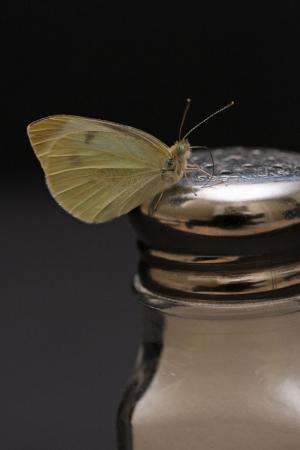Study investigates impact of road salt on butterfly development

Road salt takes a toll on lakes and rivers, but what about its impact on the organisms that live and forage at the asphalt's edge? Sodium chloride is a common remedy for icy roadways and while it makes driving easier, the ubiquitous use of road salt has played a starring role in altering patterns of sodium availability with little understood consequences for the development and evolution of wild animals.
A study by Emilie Snell-Rood published in the June 9 edition of the Proceedings of the National Academy of Sciences suggests that the availability of the micronutrient could alter selection on foraging behavior for butterflies and other roadside developing invertebrates. Living things require micronutrients such as sodium and iron in sparing amounts, but they can play a big role in development.
"Salt is normally limited in availability and sodium plays an important role in development" says Snell-Rood, a behavioral and evolutionary biologist with the U of M's College of Biological Sciences. "After experiencing my first Minnesota winter, I began wondering how road salt might be affecting the development of organisms along roadsides."
She looked to monarch butterflies as a model organism since they feed on the plentiful milkweed that grows along the county roads near Cedar Creek Ecosystem Science Reserve in East Bethel, MN, where her team collected samples.
"We compared monarchs reared on roadside-collected and prairie-collected host plants," says Snell-Rood. "Monarchs were chosen because milkweed is a common roadside plant and investment in sodium-rich muscle should be important for a migratory species like monarchs."
Snell-Rood found that road salt runoff can elevate sodium concentrations in the tissue of some plants by as much as 30 times the normal rate. When the butterflies feast on the plants, they experience a subsequent bump in sodium levels. She found that increased sodium has different effects depending on sex and can even have opposing effects on the same tissue. For example, males increase investment in flight muscle while females show the opposite pattern. Females made gains in brain size. Males did not.
While a moderate rise in sodium can have some seeming benefits, too much of a good thing is toxic. Snell-Rood found that in the control group excessive sodium led to a markedly higher mortality rate. She suggests that further study in urban areas with higher concentrations of road salt might underscore the downsides for roadside dwelling organisms.
More information: "Anthropogenic changes in sodium affect neural and muscle development in butterflies," by Emilie Snell-Rood, Anne Espeset, Christopher Boser, William A. White, and Rhea Smykalski. PNAS: www.pnas.org/cgi/doi/10.1073/pnas.1323607111
Journal information: Proceedings of the National Academy of Sciences
Provided by University of Minnesota

















